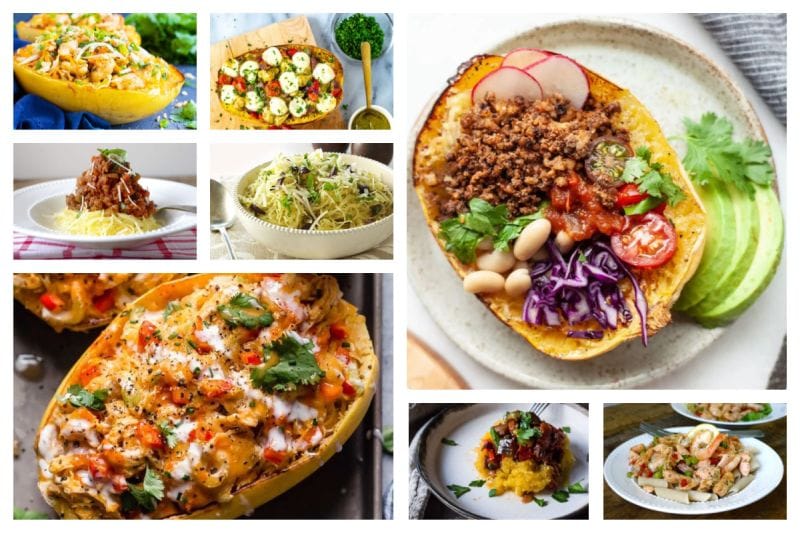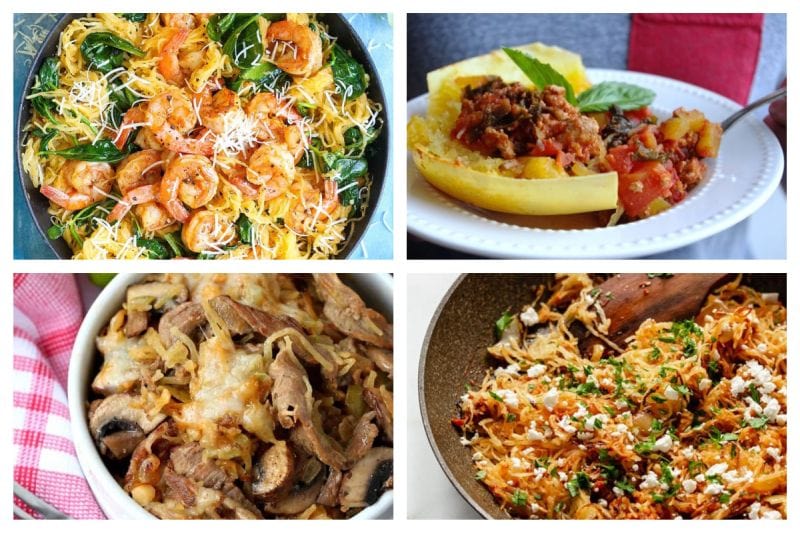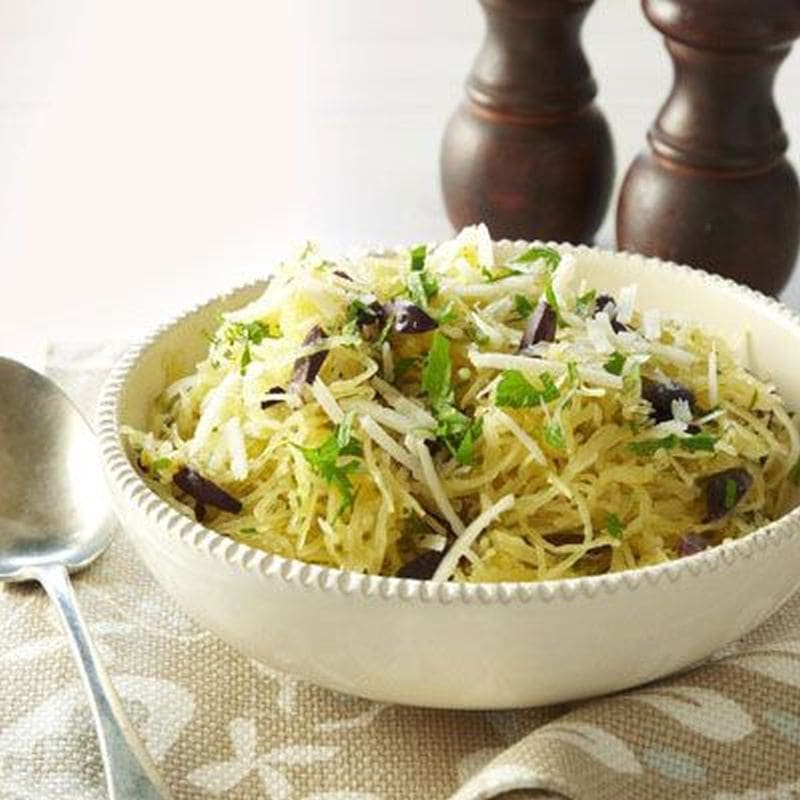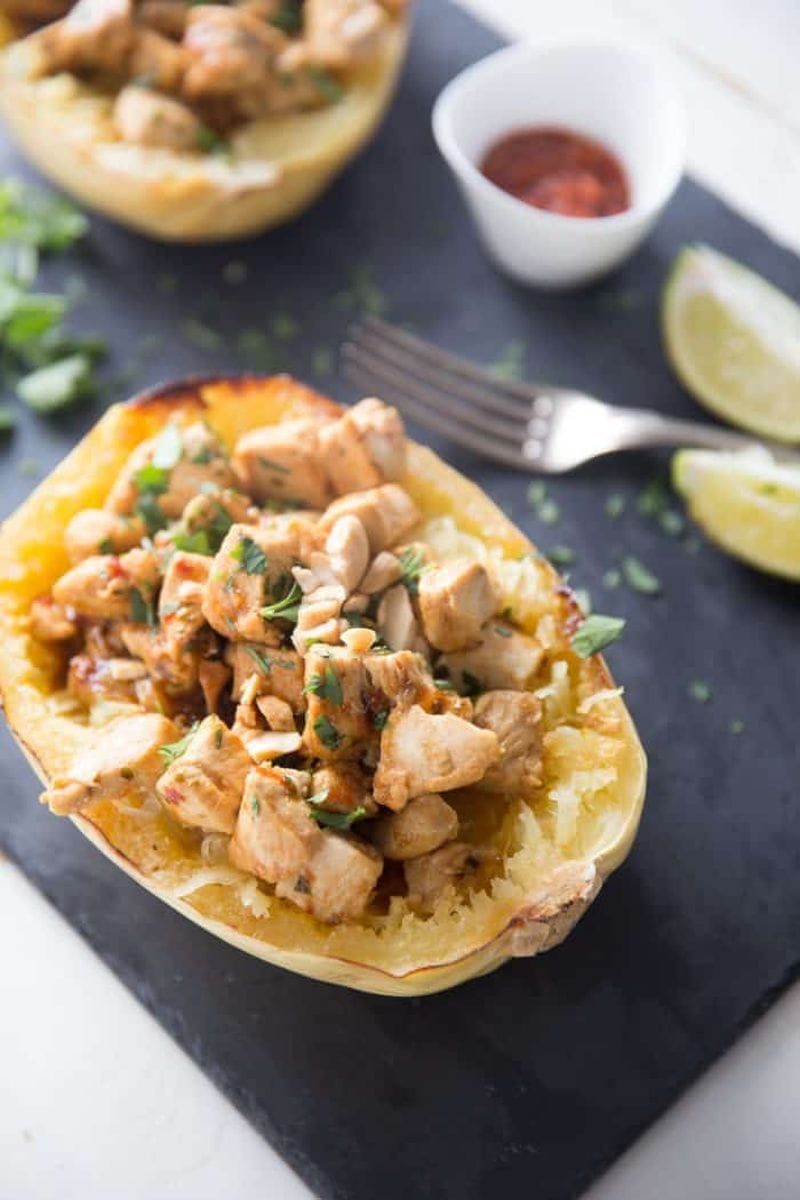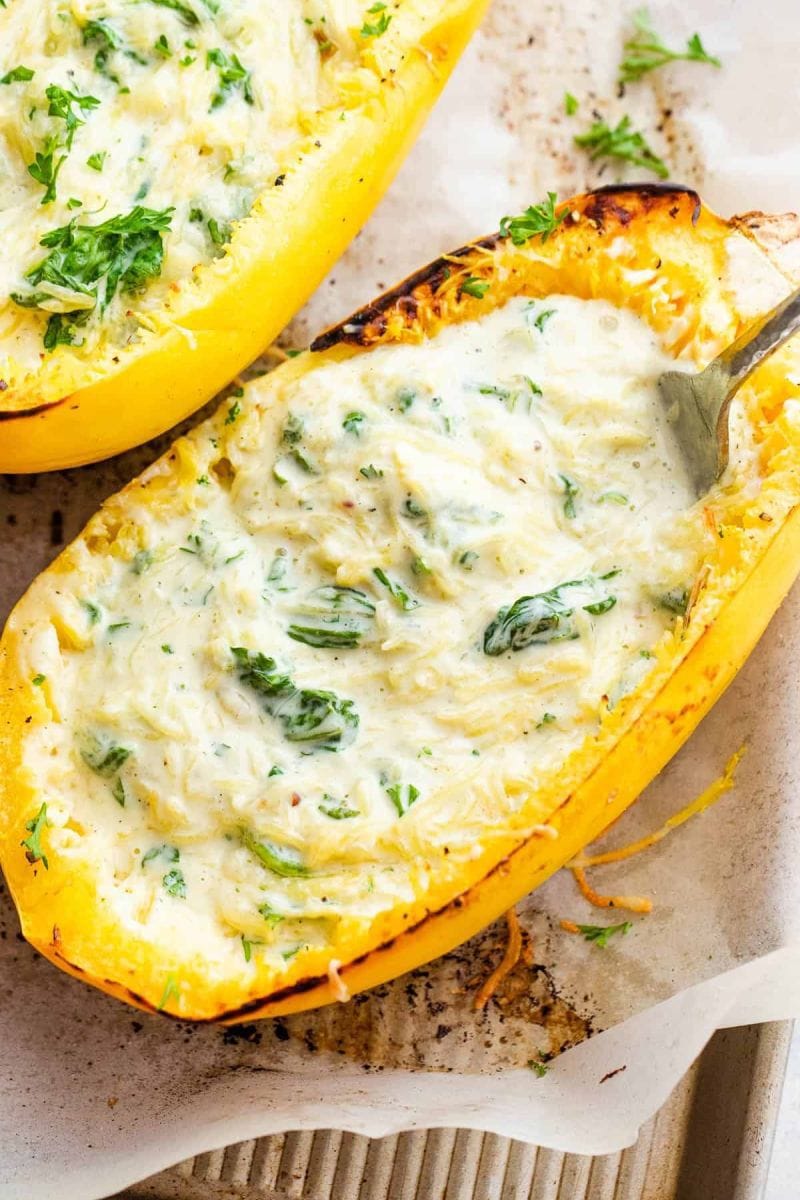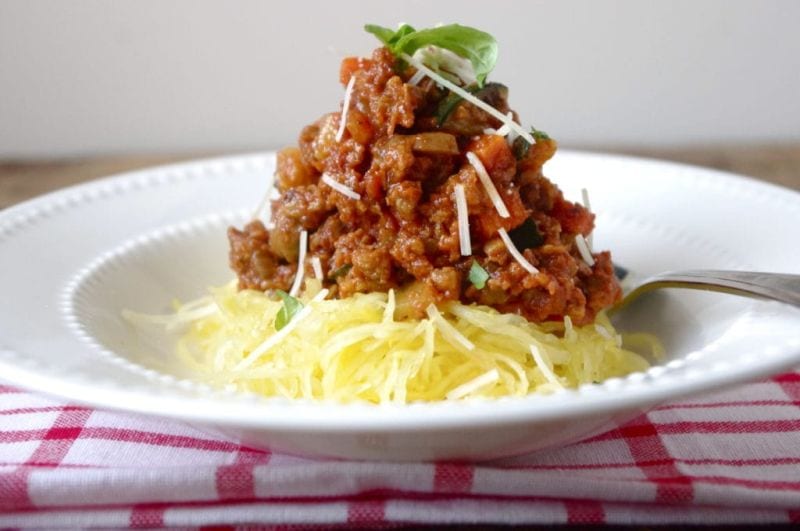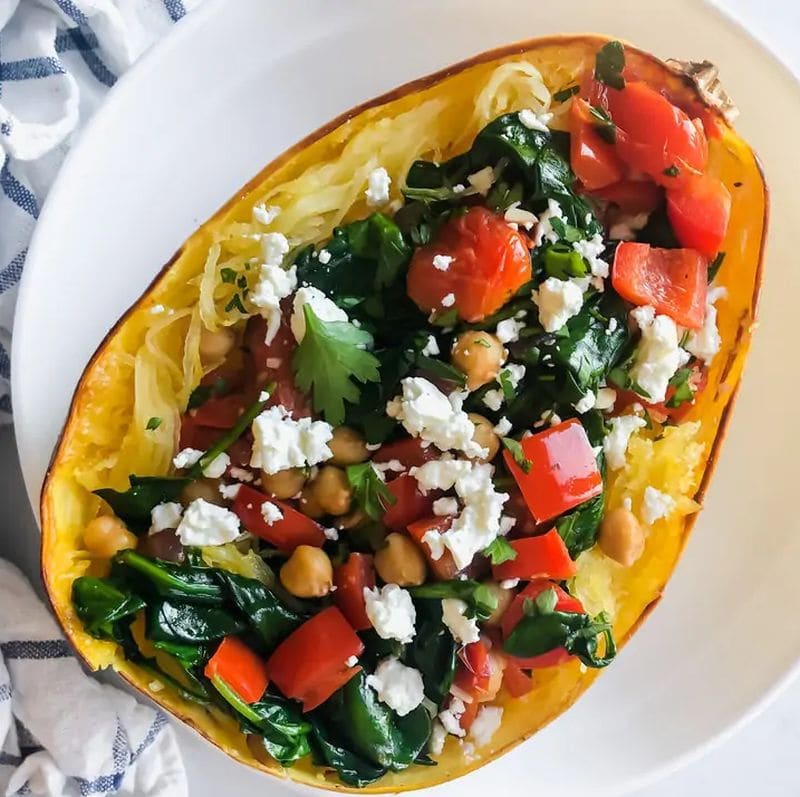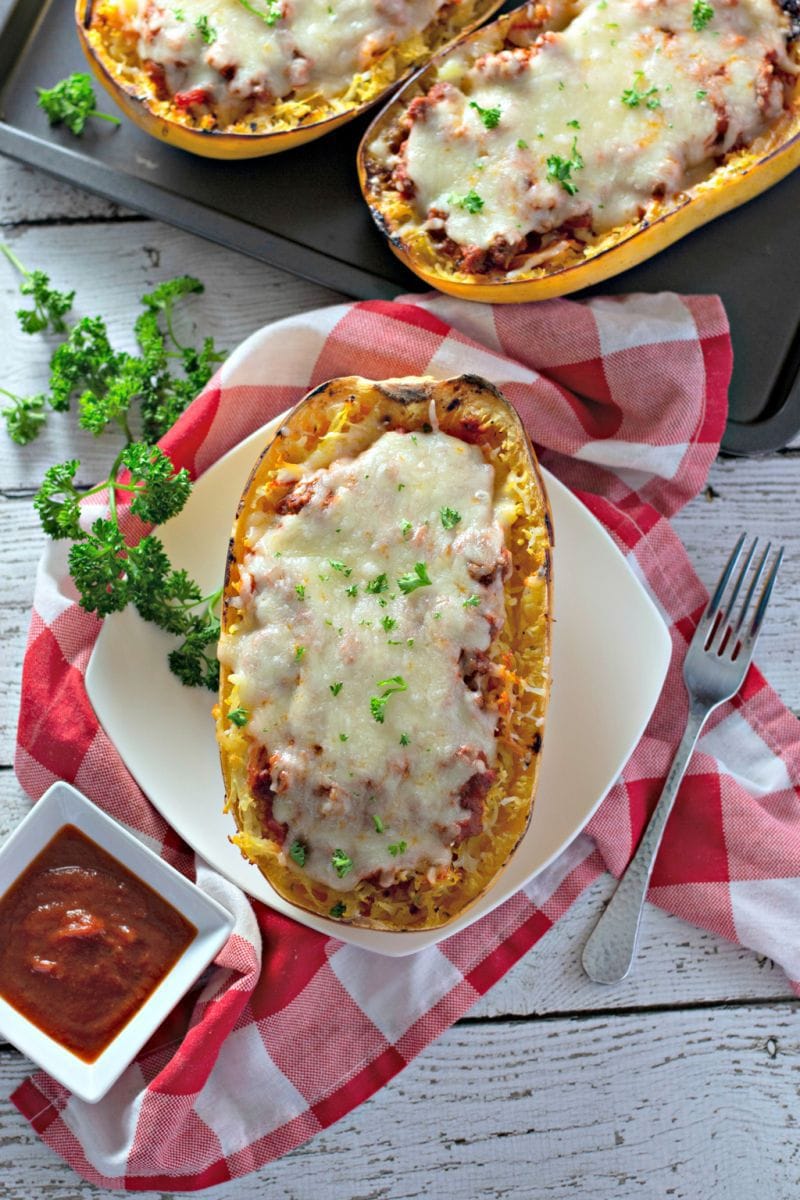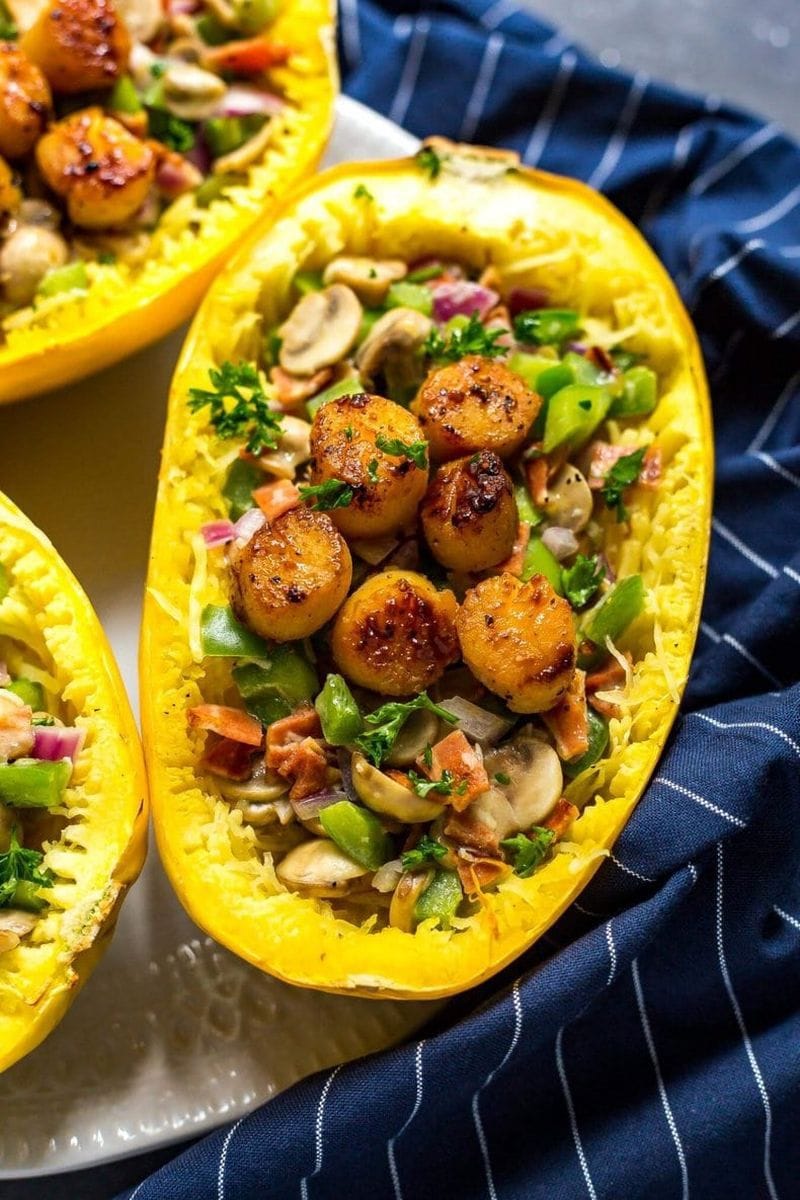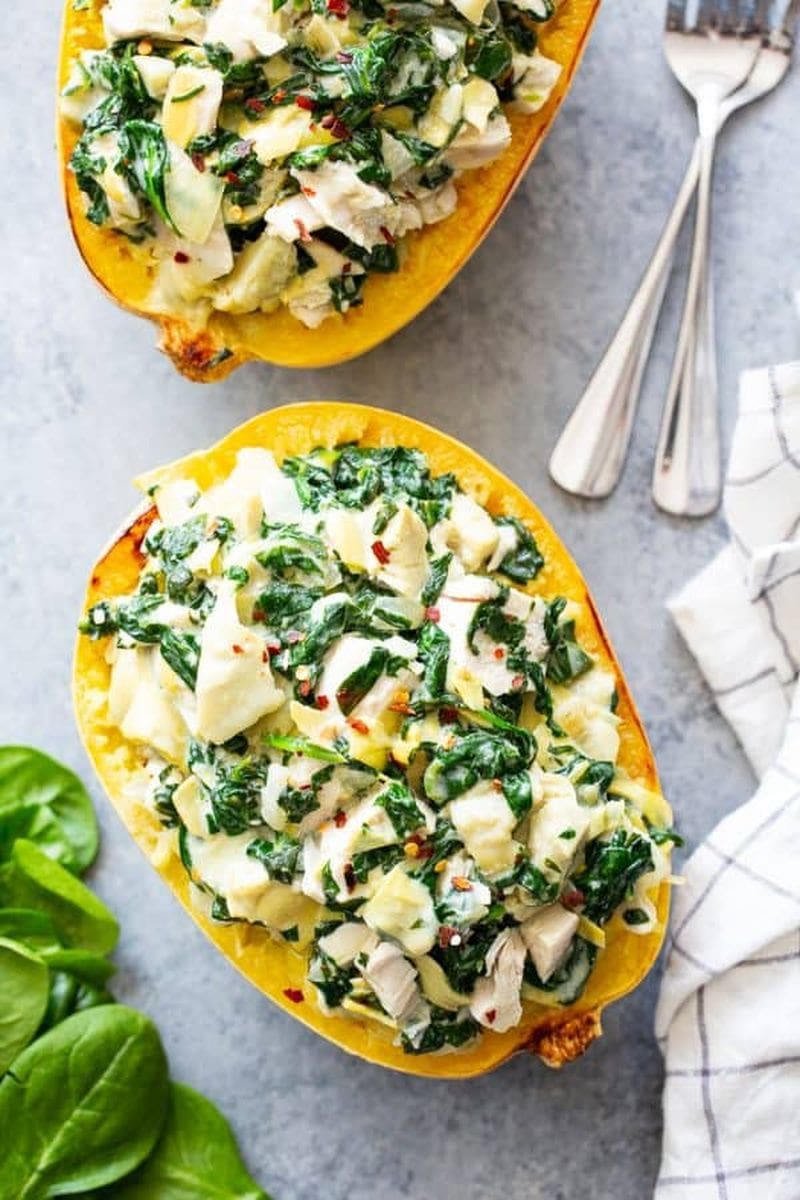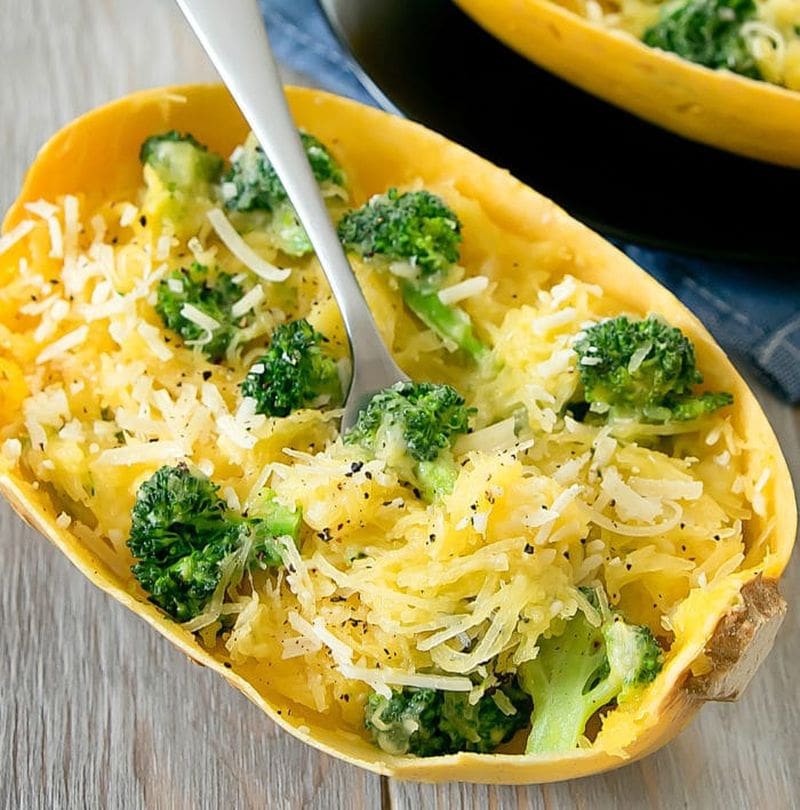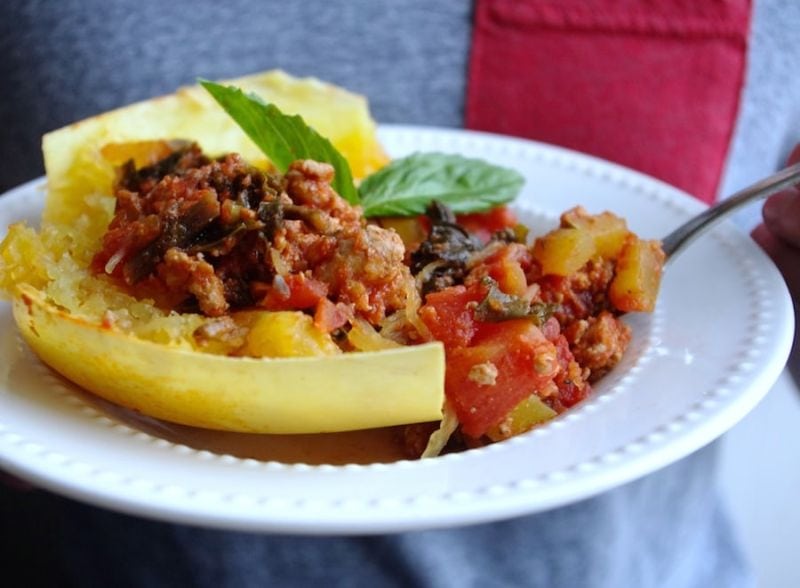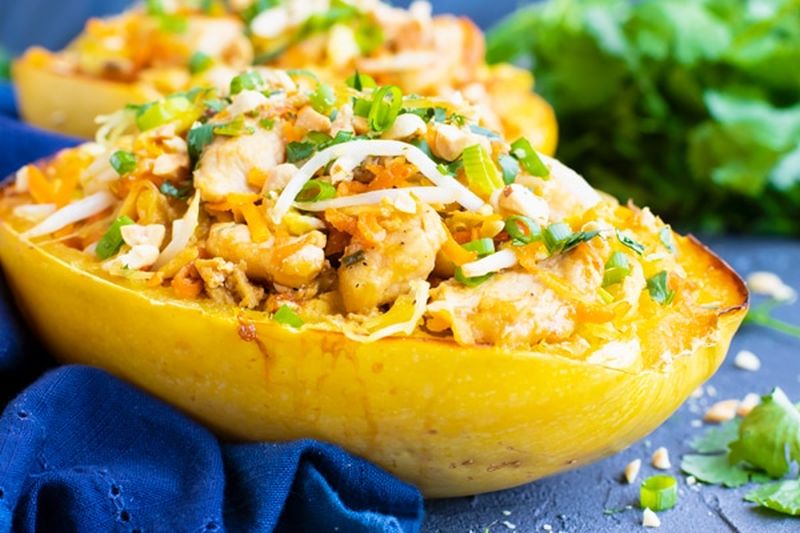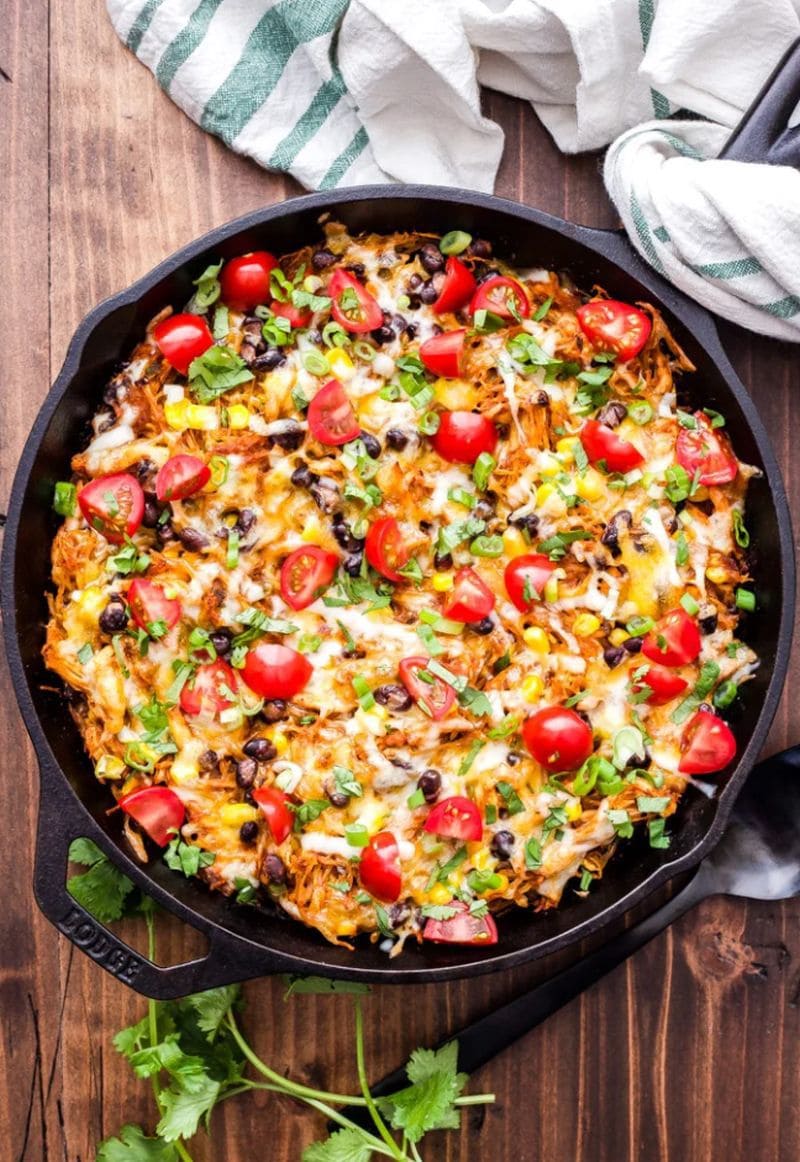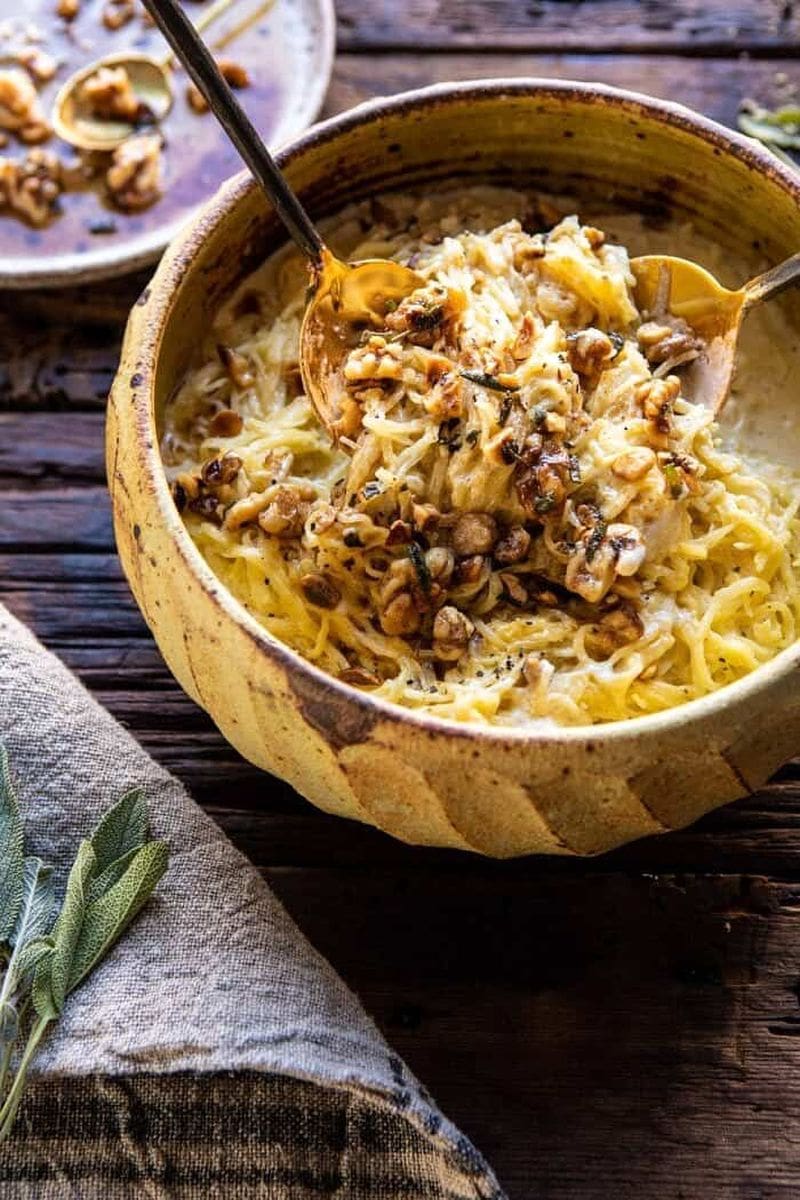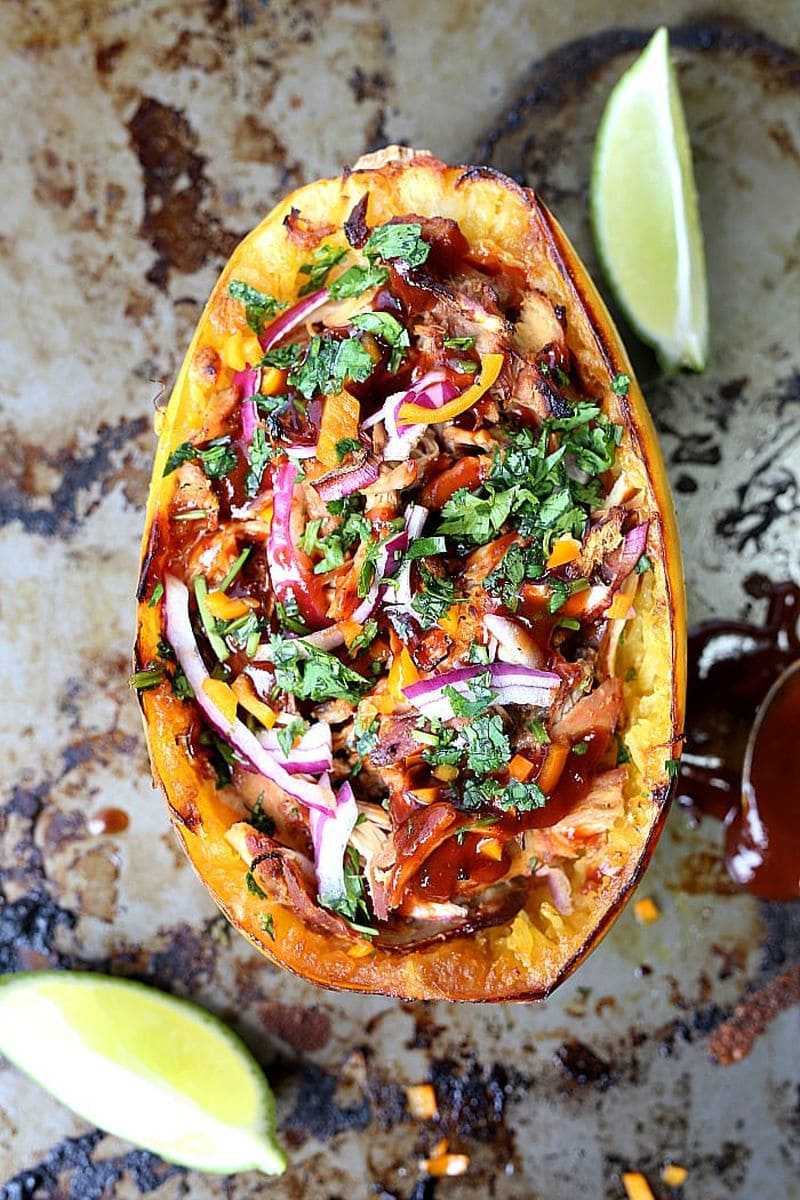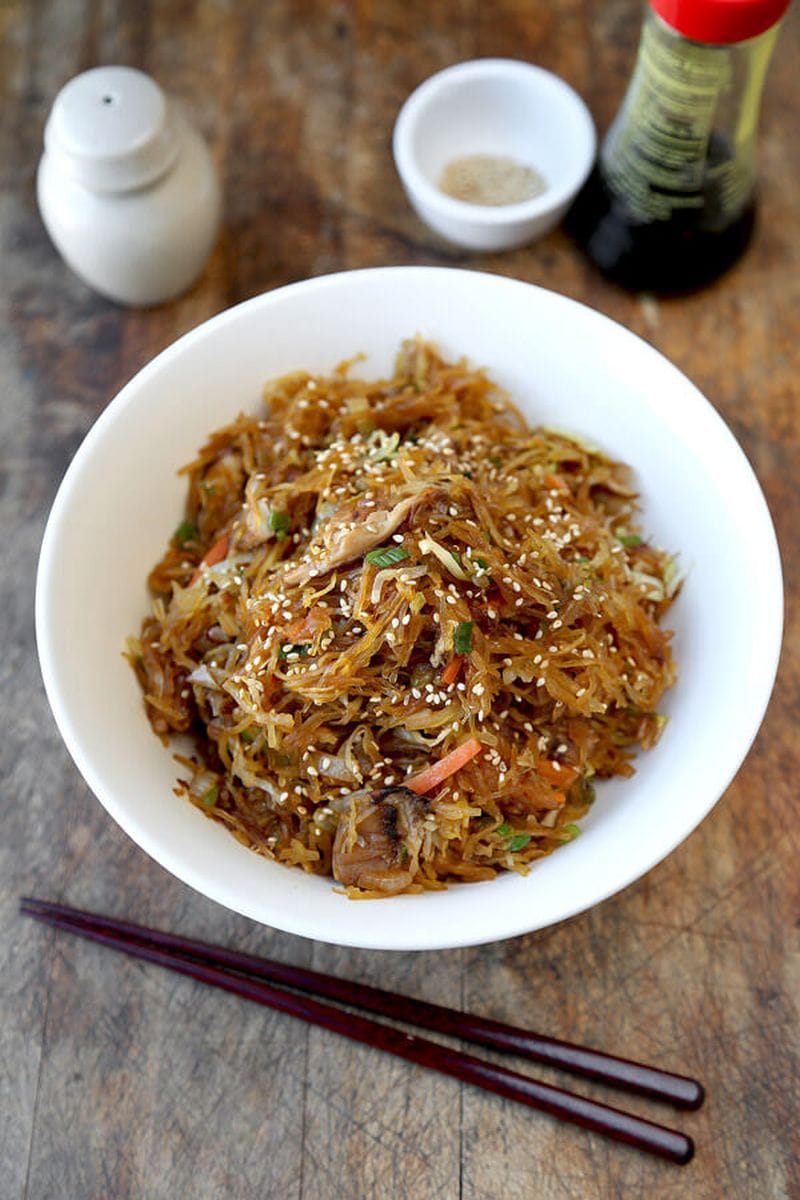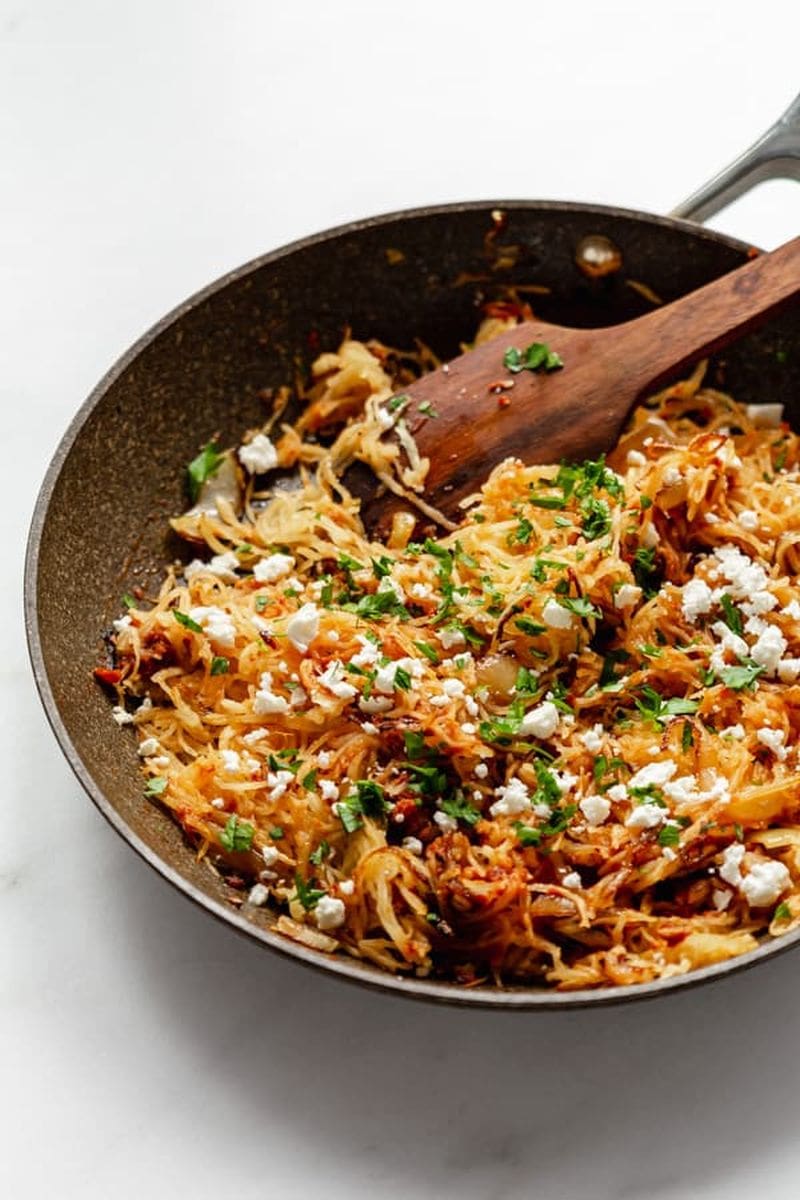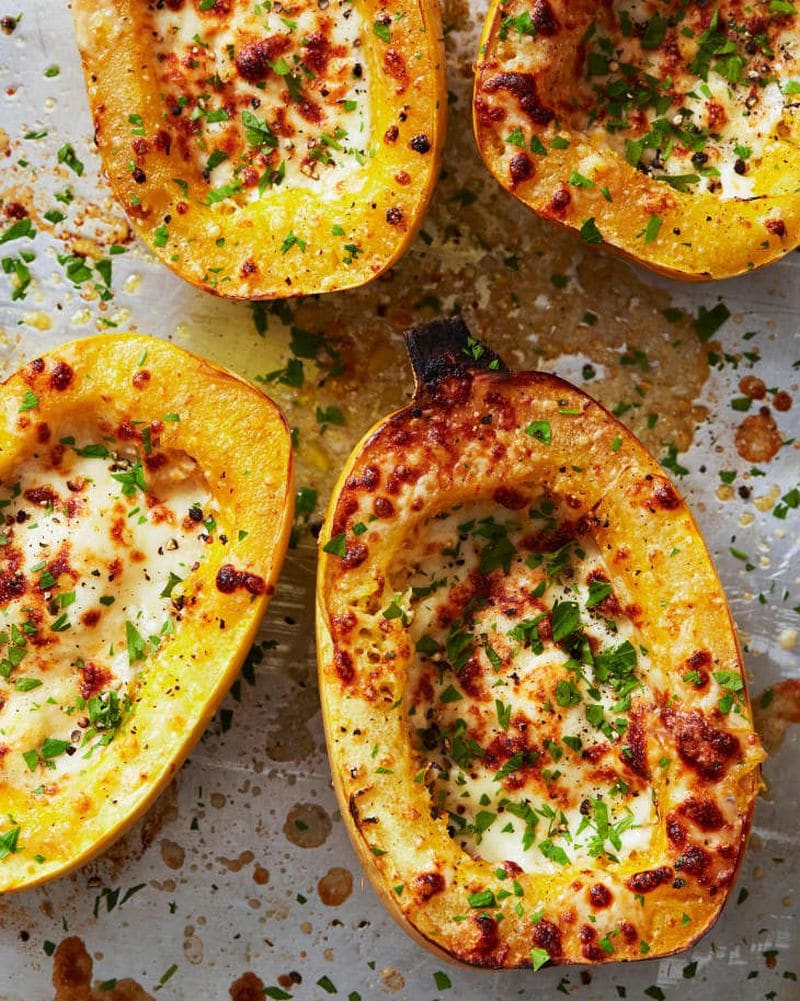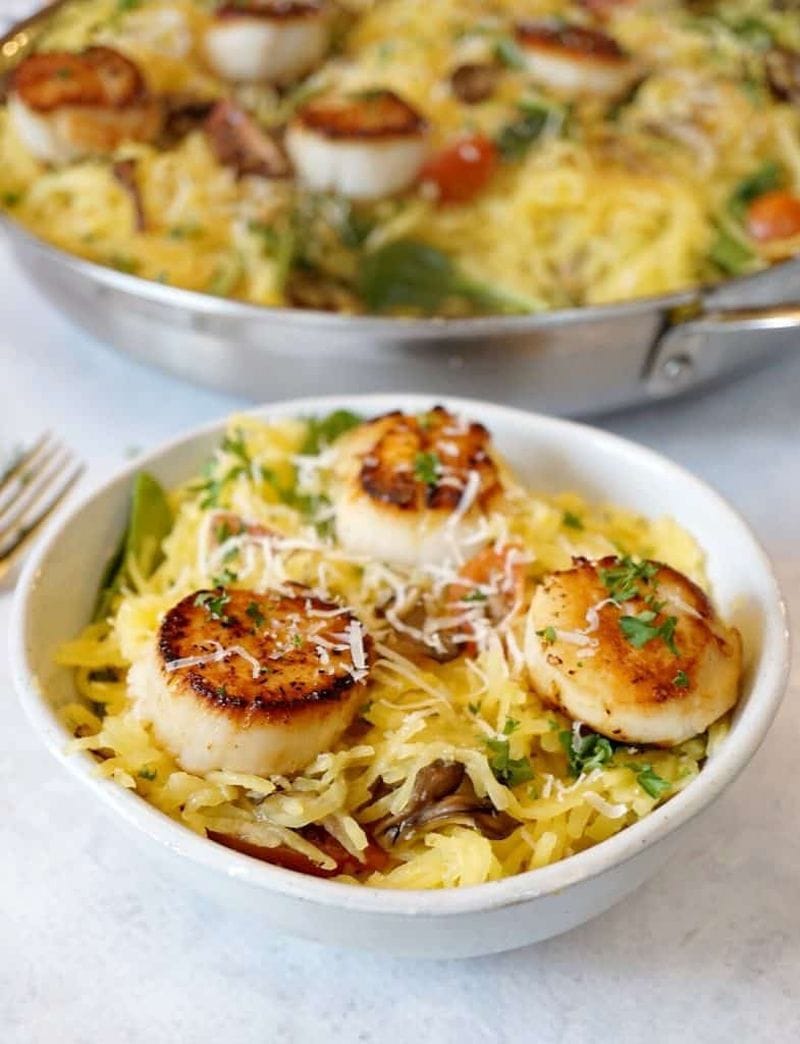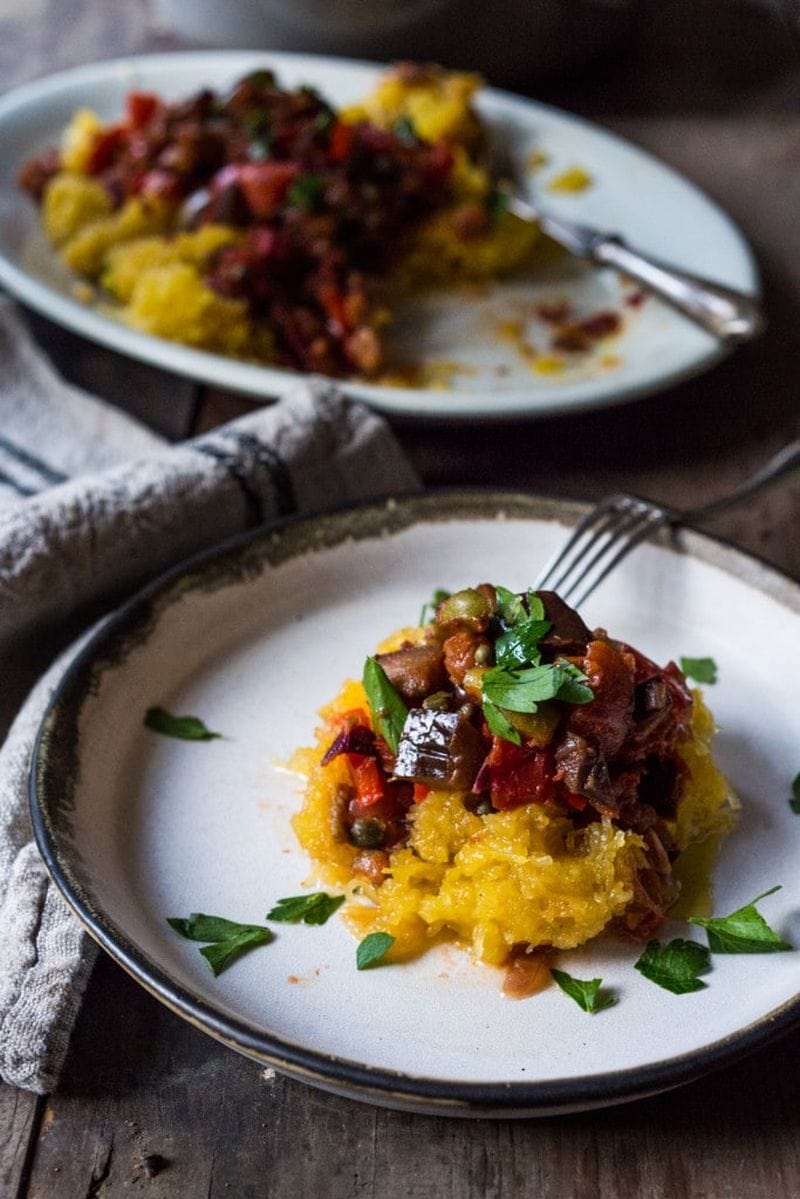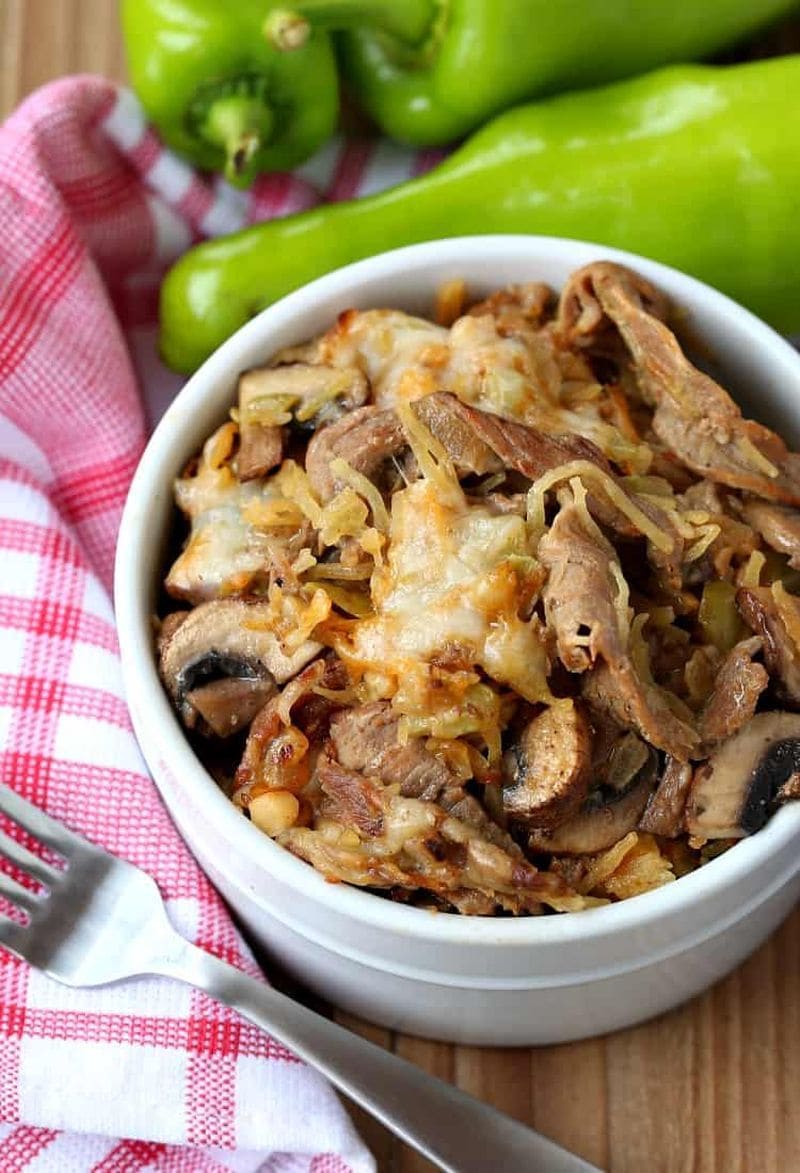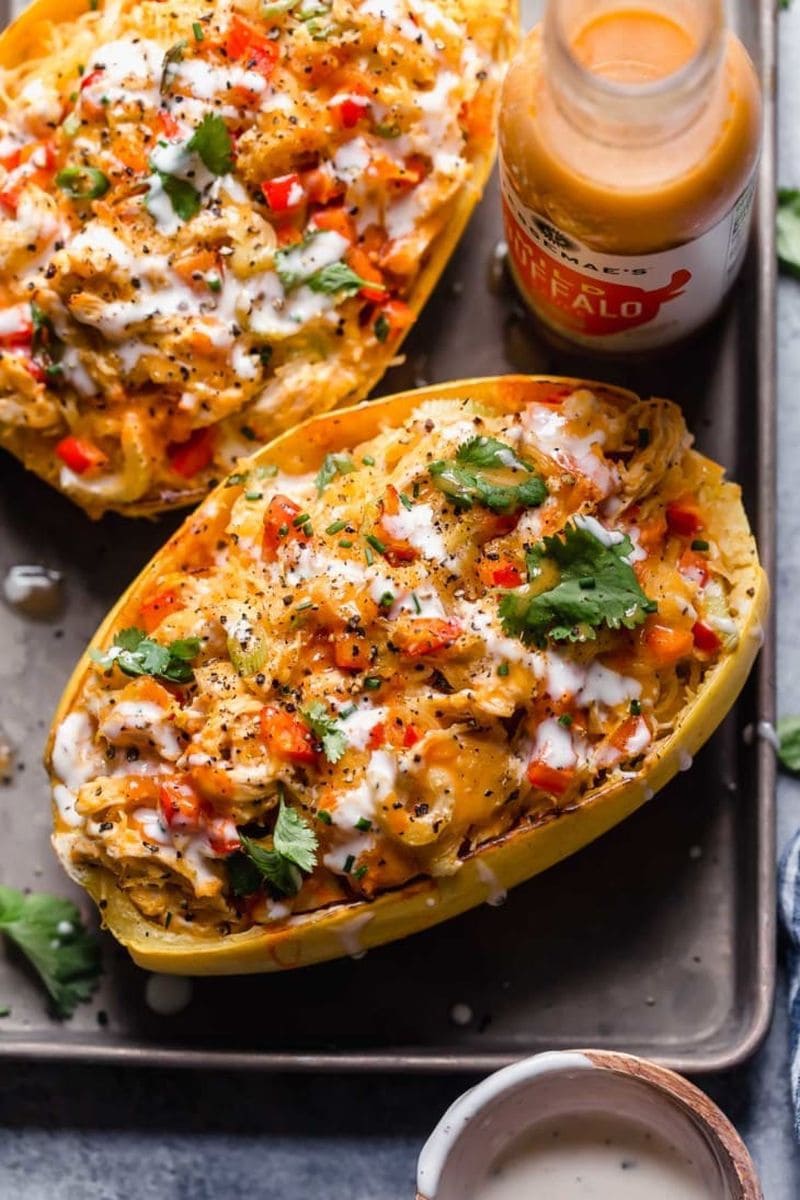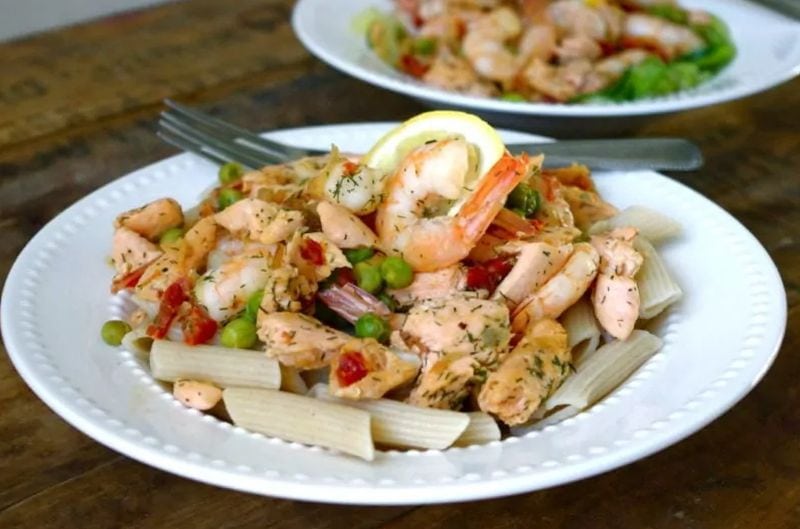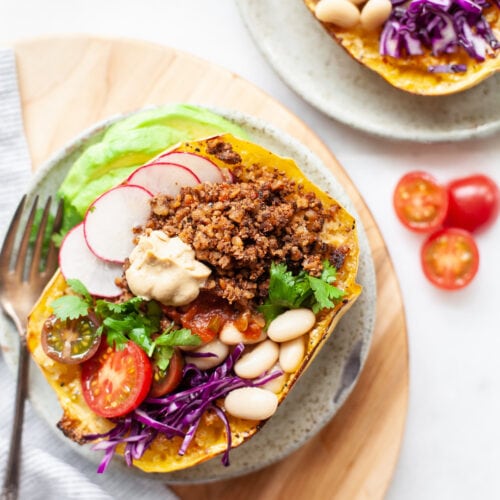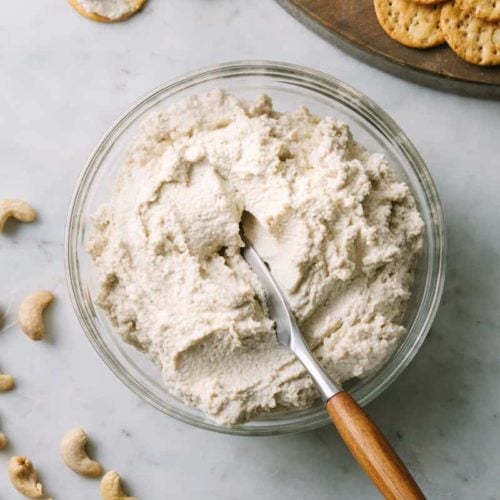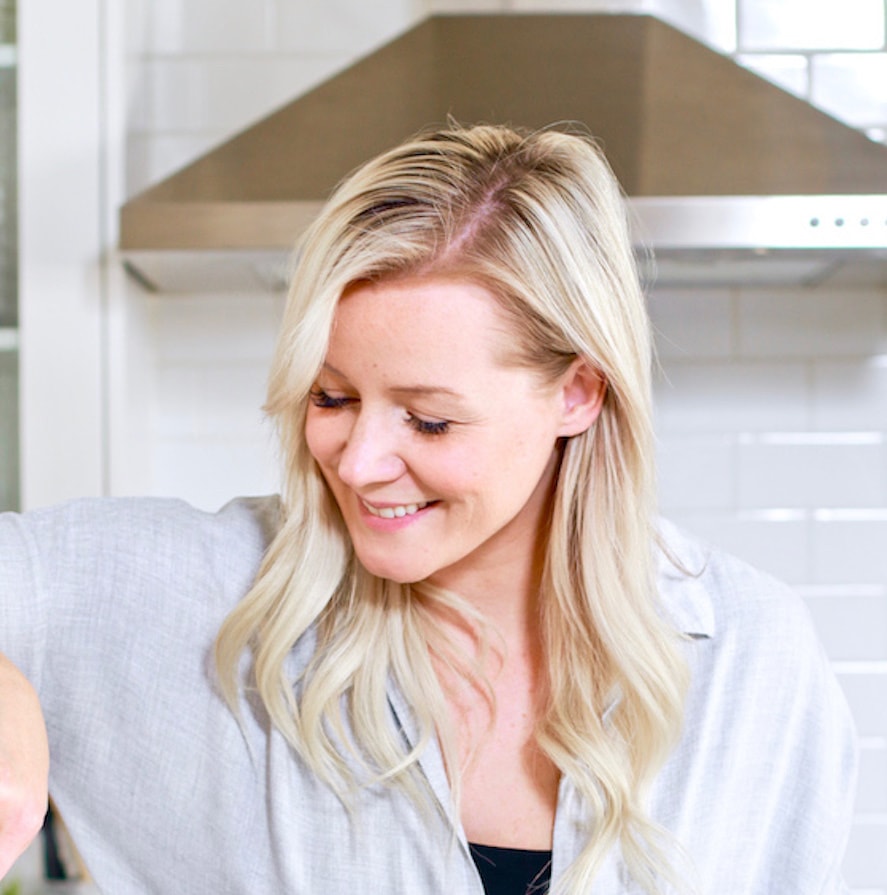Spaghetti squash is pretty trendy these days, but what if you don’t know what to do with it? Not to worry; this article will get you started with some fantastic spaghetti squash recipes.
The versatile vegetable works well as a side or main dish and comes with a host of health benefits. It’s an ideal swap for pasta if you do Keto or a similar low-carb diet.
It’s also high in vitamins and low in calories. A one-cup serving is just 42 calories but provides Vitamin C, B6, betacarotene, and fiber. It also contains 32.6 milligrams of calcium and 177 milligrams of potassium.
Some of these recipes are simple, and others quite advanced, so there’s a little something for everyone!
What is Spaghetti Squash?
Spaghetti squash is a winter squash. The spaghetti squash plant fruits and is harvested in the Fall. But its long shelflife makes it a winter vegetable, along with its brethren, butternut, and acorn squash.
The vegetable itself comes in several varieties, ranging in size and color, from pale yellow to deep orange. Like most squash, the spaghetti squash has a firm center that must be cooked before being eaten.
Once cooked, the softened interior shreds into strands resembling spaghetti or angel hair pasta.
Spaghetti squash can typically be purchased year-round because it stores so well in the right environment. But the freshest spaghetti squash can be found in September when it has just been harvested.
Like a root vegetable, spaghetti squash keeps best when stored somewhere dark and cool, like a cabinet near the floor, or a basement, if you have one.
How to Cook Spaghetti Squash
Just as there are many types of squash, there are many ways a spaghetti squash can be prepared.
Different ways of cooking this versatile veggie:
- Baked
- Roasted
- Boiled
- Microwaved
- Instant Pot
- Slow Cooker
The method you choose will depend on how much time you have and what you want to do with the cooked squash.
Roasting
The preferred method is roasting. This will yield the best results for spaghetti-like strands that you can use in any number of spaghetti squash recipes. There are a few steps to roasting squash and a couple of things to keep in mind.
If you’re having trouble cutting your squash, you can score it with a knife or puncture it with a fork and put it in the microwave for a few minutes. This will help soften the squash and make it easier to cut.
Salt is essential to the process as it draws out moisture. Moist squash equals mushy spaghetti strands.
It is suggested that you use olive oil and salt on the spaghetti squash and cook it bowl-side down, so the water ends up on the baking pan and not inside the squash. Melted butter can be used in place of olive oil if you prefer.
Because spaghetti squash is large, it is best to roast at 375 degrees for 40-50 minutes. Like pasta, this will need to be adjusted based on preference. The size of the squash will also make a difference in how long it takes to cook.
Ovens vary, and many don’t cook at accurate temperatures. Though 375 is recommended, temperatures can be adjusted by 25 degrees in either direction.
Roasting the squash will yield an al dente version of the spaghetti-type strands the squash is known for and that most recipes using it call for.
However, a few recipes allow microwaving the squash when time is in short supply. The squash can also be boiled. Once it’s cooked, how you proceed depends on the recipe you’ve chosen to use.
Below are several flavors that pair exceptionally well with spaghetti squash:
- Tomato
- Basil
- Curry
- Italian Seasoning
- Garlic
- Sage
- Parsley
- Oregano
- All types of cheeses
How Many Calories are in Spaghetti Squash Recipes?
The Spaghetti Squash on its own is very low in calories. How many calories are in your spaghetti squash recipes depends on what you add to the vegetable.
Cheesy recipes will be higher in fat and calories. But they pack an even bigger punch of calcium you may not get with other additives.
And don’t forget, no matter what you add to your spaghetti squash, the vegetable itself is full of vitamins. It’s also full of fiber that will fill you up, so you’re not hungry an hour after you eat.
What do Spaghetti Squash Recipes Go Well With?
Spaghetti squash is pretty adaptable. It can function as a main dish with sides of its own, or it can be a side dish that pairs well with meats, seafood, and pasta. In fact, in case you hadn’t guessed from the name, you can use spaghetti squash as a pasta substitute in meals.
Recipes that use the vegetable as a substitute for pasta can be a great way to do “Meatless Mondays.” It’s also ideal for swapping out some pasta carbs for vegetable ones.
Spaghetti squash is an excellent choice if you’re on a Keto-style diet. Acorn and butternut squash, which weigh in respectively at 20 and 15 net grams of carbohydrates, should typically be avoided if you’re doing Keto.
But spaghetti squash is a rockstar, with just under 8 grams of net carbs in a one-cup serving.
Other Sides that Go Well with Spaghetti Squash
How you’re preparing your spaghetti squash will make a difference in what makes the most desirable side. Below are a few suggestions.
1. Bread
Not only can you pair spaghetti squash with something like garlic bread, but you can also use it as a topping for crostini as an appetizer or on toasts for breakfast.
2. Broccoli
Broccoli is another excellent complement to spaghetti squash. And there are so many ways to prepare it. One perennially popular way is roasting it, just as you would your spaghetti squash. Suggested toppings include lemon juice, parmesan cheese, and red pepper flakes.
3. Cauliflower
Cauliflower also pairs well with spaghetti squash. Like broccoli, cauliflower can be roasted. It can also be riced to serve alongside your spaghetti squash recipes. This is particularly useful for those trying to cut back on carbs for Keto or a similar diet.
Main Proteins that Pair Well with Spaghetti Squash
Spaghetti squash also functions well as a side dish for those who are more carnivorous.
1. Beef
The easiest way to pair beef and spaghetti squash is by preparing a bolognese or meat sauce and pouring it over the squash noodles. The squash can also serve as a bowl for burritos. This can help increase protein and cut carbs if you’re so inclined.
2. Lamb
A leg or rack of lamb also works well with spaghetti squash. A mint sauce can be prepared for the lamb, or mint leaves can be added to the spaghetti squash. Or you could simply toss the spaghetti squash with some olive oil and serve it on the side.
3. Pork
Another protein that pairs nicely with spaghetti squash is pork, and it can be used in several ways. Pork medallions, for instance, could be served over your spaghetti squash with a cranberry or mushroom sauce.
Or you could stir fry the pork and serve it over spaghetti squash noodles with a ginger or garlic sauce.
4. Poultry
Chicken also does well in a spaghetti squash stir-fry. But because both chicken and spaghetti squash takes seasoning well, there are several other options. Adding tomatoes, Italian seasoning, or curry are just a few. More can be found in the list of recipes below.
31 Tasty Spaghetti Squash Recipes
1. Spaghetti Squash Burrito Bowls
Spaghetti squash makes an excellent bowl for your meals. There are even options to make them dairy-free and vegan-friendly like Nutrition in the Kitch does in this recipe.
Options like walnut or tofu meat can be used as substitutes for those who are vegan, or beef or chicken could be used for those who are not.
And when you’re using your spaghetti squash as a bowl, you can prepare it in several ways: roasting, microwaving or cooking in a slow-cooker or instant pot.
2. Spaghetti Squash with Olives and Pecorino
If you’re looking for something a little simpler or maybe lighter, Country Living has this tasty recipe to try. The longest part of the prep on this one is roasting the squash.
Once that’s done, and you “spaghetti” your squash, all you have to do is toss it with the remaining ingredients.
3. Sweet and Spicy Chicken
Lemons for Lulu has a recipe that will satisfy your cravings for a more Asian-style meal. The sweet and spicy chicken cooked in a sauce made from garlic, ginger, hoisin sauce, Thai chili paste, and cashews tops a spaghetti squash bowl.
If you’re looking to add a kick to your dinner tonight, you should definitely give Sweet and Spicy Chicken over Spaghetti Squash a try.
4. Creamy Spaghetti Squash
This alternative to pasta alfredo from Diethood works as a main dish or even as a side. The sauce is a creamy blend of mozzarella and parmesan, with some baby spinach to kick up the healthiness. Steak, salmon, and chicken are all excellent options for pairing.
5. Spaghetti Squash with Veggie Bolognese Sauce
If you’re looking to cut carbs, this recipe from Nutrition in the Kitch might be the way to go. What makes it even better is that it uses a vegetarian Bolognese. Using a plant-based meat replacement in this recipe makes the calorie count for one serving less than 300 calories.
And with all the fiber you get from the spaghetti squash and veggies in this recipe, it will surely leave you full and satisfied.
6. Mediterannean Spaghetti Squash
Many people decide to try spaghetti squash because they are on Keto, Atkins, or another low-carb style diet. But the Mediterranean Diet is having a bit of a moment, too.
This recipe satisfies the demands of both. In addition to the low-carb squash, it contains chickpeas and feta: Mediterranean Diet gold.
7. Baked Spaghetti Squash with Meat Sauce
Looking for a different way to use meat sauce with your spaghetti squash? The Life, Family, and Fun website has a fabulous recipe for Baked Spaghetti with Meat Sauce. Like the first two recipes on this list, the spaghetti squash in this recipe is used as a bowl.
With ingredients like tomato sauce, garlic, mozzarella, and parmesan, this would make an excellent substitute for low-carb seekers who like chicken or eggplant parmigiana.
8. Chicken Pesto Spaghetti Squash
This flavor-packed gem from The Girl on Bloor requires a higher temperature of 425 degrees but only 35 minutes in the oven. That makes it an ideal choice for busy work and school nights.
Especially since you can prep the chicken, peppers, onion, and bocconcini (mozzarella balls) while your squash is cooking.
9. Spaghetti Squash “Pizza” Bowls
You might even get your kids to eat spaghetti squash with this gem of a recipe from Cookie and Kate. Spaghetti squash is filled with garlic and spinach, marinara, and mozzarella cheese.
As a bonus, this one stores up to 4 days in the refrigerator and reheats well in the microwave.
10. Healthy Scallop Spaghetti Squash Carbonara
There’s a little more prep involved with this recipe, but it comes in at just 399 calories a serving. And it presents well enough you could wow your next dinner guests with it.
If you have a small household, that may be a wise decision, as leftovers will only keep for a couple of days. Still, the bacon cream sauce and scallops make it worth trying this one at least once.
11. Spaghetti Squash Alfredo
This version of the creamy pasta dish comes from Country Living, and the squash can be prepared in the microwave. It’s then topped with a creamy cheese sauce prepared stovetop and broiled in the oven to turn the mozzarella topping a delightful golden brown.
12. Chicken Spinach Artichoke
Who doesn’t love spinach artichoke dip? This recipe from Paleo Running Momma combines the deliciousness of your favorite party dip with the health benefits of chicken and spaghetti squash.
The recipe is Paleo and Whole 30-compliant and offers options tailored to you. You can use ghee or coconut oil, nutritional yeast or parmesan cheese, and olive or avocado oil.
Recipes like this chicken spinach artichoke spaghetti squash can make all the difference when tackling the challenge of something like the Whole 30.
13. Spaghetti Squash Casserole
If you’re looking to make a big meal with your spaghetti squash, Well-Plated has you covered. This one combines the cooked strands with ground turkey, onion, garlic, and mozzarella cheese.
The flavors are similar to what you would find in lasagna, but only 193 calories per serving.
14. Instant Pot Cheesy Garlic Spaghetti Squash
This is another option that could be used as a main meal or a side dish. And it cooks upright in your instant pot. And when you cook spaghetti squash in an instant pot, you don’t have to cut it in half first.
You put the whole squash right in, which makes this ideal for people who struggle to cut through the thick skin associated with the vegetable.
The instant pot is also ideal for those who are short on time. The spaghetti squash cooks in just fifteen minutes this way, and then you switch to the saute function to melt butter and cook the garlic and broccoli.
Strands from the squash and cheese are added, and the whole thing can be served back inside the squash “bowl.”
15. Shrimp Scampi Spaghetti Squash
This is another example of spaghetti squash as a substitute for pasta that dramatically cuts the calories. The squash will have to bake or roast for 35-45 minutes, so it will take longer to prepare than its pasta counterpart.
But it has all of the flavor, half the calories, and gives you a boost of nutrients from squash, spinach, and lean protein.
16. “Squash Bowl” Garden Vegetable Turkey Bolognese
Nutrition in the Kitch does another twist on the bowl with this delightful recipe. You could make this vegan or vegetarian if you chose. Or you can keep it as is with a leaner ground meat option.
Either way, it’s sure to please, and you’ll get extra nutrients and vitamins with add-ins like Kale, carrots, and mushrooms.
17. Chicken Pad Thai
If you’re looking for a taste that’s more Asian than Italian, this spaghetti squash chicken pad Thai recipe from Evolving Table is sure to satisfy. It’s also Paleo, dairy-free, and gluten-free.
Some ingredients, like coconut aminos or gluten-free soy sauce and garlic chili paste, could be more challenging to shop for than those in other recipes. But others are easy to come by: carrots, green onion, chicken, apple cider vinegar.
You can also tailor your toppings to taste, taking or leaving the peanuts and bean sprouts according to preference and allergy considerations. But you’ll want to keep the cilantro and lime juice.
18. Southwest Casserole
Here’s a different take on spaghetti squash in a casserole. This recipe from Recipe Runner cooks up in a skillet and has all of your favorite southwest flavors.
It combines spaghetti squash with chicken, black beans, corn, enchilada sauce, green onions, and cheese with tacolike seasonings of chili powder, cumin, and garlic. All that flavor, and only 386 calories.
19. Creamed Spaghetti Squash with Browned Butter Walnuts
This side dish from Half Baked Harvest is very different from the other options in this list. But it would be a lovely side to serve up for whichever Fall and Winter holidays you happen to celebrate.
The walnuts are browned on the stovetop in butter, sage, and a pinch of salt, and the roasted spaghetti squash is tossed with a sauce made from goat cheese, Manchego cheese, pesto, and nut milk.
20. Barbecue Chicken Stuffed Spaghetti Squash
This recipe from Delightful Mom Food can bring a little taste of summer to your winter squash. It’s also easy to adapt. Have leftover chicken you want to use up? This would be an ideal way to do it.
Want something more manageable than prepping the chicken and the squash? Pick up a pre-cooked rotisserie chicken at the store. You can shred the chicken and toss it with the barbecue sauce while the squash is cooking.
21. Spaghetti Squash Yakisoba Style
Yakisoba noodles are delicious, and this spaghetti squash recipe from Pickled Plum lets you make it low-carb and more calorie-conscious. The squash in this recipe cooks up in the microwave in just 10-12 minutes.
It’s only 154 calories per serving, and the leftovers will last for 2 days in the refrigerator.
22. Sundried Tomato Spaghetti Squash with Caramelized Onions
Choosing Chia offers this fresh option, with homemade sundried tomato pesto and caramelized onions that can be prepared while your squash is cooking. Caramelizing onions takes some time and patience.
The 15-20 minutes recommended will kill some of the time you would otherwise be waiting for the squash to cook.
23. Cheesy Garlic Parmesan
This tasty treat from The Kitchn can be the main meal or a side dish. Garlic powder is responsible for the delightful aroma and taste in this dish.
If you’re looking to make it more quickly, the squash can be roasted a day ahead and reheated with the remaining ingredients the next day. If you choose this option, your meal or side will be ready in just fifteen to twenty minutes.
This ooey-gooey cheesy garlic parmesan spaghetti squash concoction is sure to please even the least healthy eater in your household, and they may not even realize they’re eating a vegetable.
24. Roasted Spaghetti Squash with Parmesan Mushrooms
Here’s a vegetarian option for you from Well Plated by Erin. The spaghetti squash in this recipe is roasted and then tossed with spinach and mushrooms sauteed in garlic and thyme.
Parmesan and parsley get stirred into the mix, and then some more parmesan is added to the top for serving. If you’re a vegetarian who loves cheese, this could be your new favorite recipe.
25. Scallops and Spaghetti Squash with a Lemon Cream Sauce
JZ Eats uses spaghetti squash in this recipe that will have your taste buds singing. The recipe calls for Maitake mushrooms, known for their health benefits but possibly harder to come by.
You can swap them out for shitake or baby Bella mushrooms based on preference and availability. The lemon cream sauce perfectly complements the scallops and cheese and pairs well with the spaghetti squash.
The mushrooms are sauteed in the same skillet you used for the scallops, and all the ingredients are mixed there before serving, cutting down on the cleanup you’ll have at the end of this meal.
26. Eggplant Puttanesca with Roasted Spaghetti Squash
This recipe from Fasting At Home kicks things up a notch at the dinner table. Not only does it taste fantastic, but it also presents beautifully. The eggplant puttanesca is prepared while your squash is roasting, saving you time when you’re preparing your meal.
This vegan puttanesca is a compelling blend of eggplant, garlic, bell pepper, wine, chili flakes, capers, and olives.
27. Philly Cheesesteak Casserole
If you’re looking to satisfy the red meat eaters in your household while feeding the whole family, this spaghetti squash recipe from Mantitlement may be your best bet.
Since spaghetti squash picks up the flavors of the other foods you are cooking it with, this casserole will taste just like your favorite submarine sandwich.
The recipe calls for shaved beef, which will produce the best likeness to the sandwich. But you could use ground beef instead, or even ground turkey.
Mixed together with mushrooms, onions, peppers, Worcestershire sauce, and cheese, this casserole will fill up even your heartiest eaters, as well as the ones least likely to eat their vegetables.
28. Spaghetti Squash Breadsticks
Here’s an inventive option from Kirbie’s Cravings. You’ll have to cook the squash first, then chop up the long strands that the vegetable is known for to get this recipe to work.
You’ll also need to wring as much water as possible out of your squash strands before turning them into breadsticks.
Once that’s done, you mix the squash with egg, cheese, Italian seasoning, and almond flour, then shape the dough into an oval that will be baked in the oven. Mozarella and parmesan get sprinkled on top before baking 6-8 minutes at 425 degrees.
29. Cajun Chicken Bake
If you like things spicy, this recipe from Destination Delish could satisfy your cravings. Chicken is tossed in cajun seasoning and cooked in a skillet while the squash is roasting.
After the chicken is fully cooked and set aside to rest, your veggies go into the same skillet. Onions, bell peppers, and garlic also get tossed with more cajun seasoning before diced tomatoes and cream cheese are added.
As soon as the squash is done, it gets stirred into the vegetables with the chicken and baked for twenty minutes. Parmesan cheese is then sprinkled over the finished product.
30. Buffalo Chicken Spaghetti Squash
The Real Food Dietitians offer a healthy twist on a favorite appetizer in this recipe. While the squash is baking, you can prepare your chicken either on the stovetop or in an instant pot.
When the chicken is fully cooked, it is then shredded and tossed with your favorite brand of buffalo sauce, chopped celery, green onions, bell pepper, and spaghetti squash.
Everything goes back in the squash “bowls” and cooks at 350 degrees for 10-15 minutes. Once heated through, the bowls can be topped with ranch dressing and crumbled blue cheese.
31. Pasta Al Pacifico
This last recipe for spaghetti squash actually calls for zucchini or whole wheat pasta, but spaghetti squash could easily be substituted. It also meets the needs of pescatarians or anyone looking to cut back on their meat consumption.
Fish and seafood are excellent healthy protein sources. The sundried tomatoes, dill, salmon, and prawns in this make for a super tasty dish you will love. And it presents well enough to easily serve to friends and family at your next get-together.
FAQ
When Should You Not Eat Spaghetti Squash?
Eating too much squash could increase your chances of cucurbit poisoning or “Toxic Squash Syndrome.” Fortunately, the condition is rare, and squash containing the toxic compound tastes bitter. Any time your squash tastes particularly bitter, it’s best not to eat it.
You also want to avoid using squash that has gone bad. Squash that is okay to use should be firm and pale yellow in color. Remember, some types of spaghetti squash are darker-hued than others.
If the squash feels squishy, has dark yellow or brown spots, or leaks any kind of liquid, you should dispose of it and buy a fresh squash before you start cooking.
Should Spaghetti Squash Be Refrigerated?
Once prepared, any spaghetti squash recipe should be refrigerated or frozen. But what about before you cook it?
Uncut spaghetti squash should not be kept in a refrigerator. It should be kept in a cool, dry environment, like onions and potatoes.
After being cut, any leftover, uncooked spaghetti squash should be refrigerated. The ideal place to store your cut spaghetti squash is in the humidity-controlled drawers.
As soon as the spaghetti squash is cooked, it can be kept in the refrigerator or freezer. If you are freezing it, it must be in an airtight bag. In the fridge, it will keep for two to three days.
The length of time you can store spaghetti squash recipes depends on what other ingredients are in them. Always refer to instructions in the recipe for guidance.
Can You Freeze Spaghetti Squash?
Cooked spaghetti squash and its recipes can be frozen, but many people prefer not to. Because of the high water content, squash that has been frozen and thawed can become mushy.
Other ingredients in the recipes may also make freezing an unwise option. Cooked seafood, for instance, tends not to freeze and thaw well.
If you choose to cook and freeze spaghetti squash for future use, there are some best practices. Draining the squash is vital. Put it in a colander over a bowl in the refrigerator for no less than 12 hours. Once it’s drained, you can seal it in airtight freezer bags.
To get the best longevity on your frozen squash, you should remove as much air as possible from the bags before putting them in the freezer. Label and date the bags before freezing. Your cooked squash will last up to 8 months this way.
Are Spaghetti Squash Recipes Considered Starchy Vegetable Dishes?
While some squash, like acorn and butternut, are considered starchy vegetables, the spaghetti squash is not. Its makeup is closer to that of a vegetable than a starch.
In general, this means your spaghetti squash recipes will also be considered non-starchy. However, keep in mind that other items you add to your spaghetti squash recipes could change how starchy a dish you end up with.
Conclusion
Spaghetti squash is a fascinating vegetable that often replaces the pasta it shares a name with. The vegetable picks up the flavors of anything it is cooked with, making it versatile.
It pairs well with proteins and other vegetables and does exceptionally well with cheeses. It can be used in Asian, Italian, Mexican, and American recipes as the main meal or a side dish. The only limit to using spaghetti squash is your imagination.
In addition to being low-carb, spaghetti squash is also low-calorie and high in vitamins, calcium, and potassium, which can improve health and well-being.
The vegetable stores well in cool, dark places for up to 3 months but should be kept in a humidity-controlled drawer of the fridge once cut. Following specific guidelines, spaghetti squash can be frozen and last the better part of a year.
This non-starchy vegetable is popular and available year-round in most locations. Give one of these spaghetti squash recipes a try today, and experiment with all of the ways you can change up your dinner routine.

